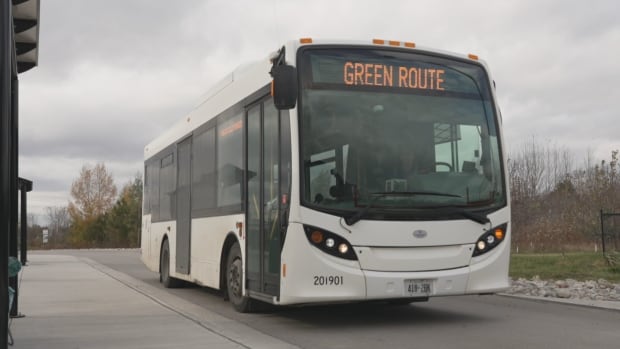While public transit in many Canadian cities struggles with fares going up and ridership going down, in one community the passenger count has more than doubled in the past two years.
Transit ridership in the town of Orangeville, Ont., will, by the end of the year, have increased by 150 to 160 per cent, according to Mayor Lisa Post.
“It’s really impacting the entire community positively,” she said.
The reason for that big spike? Orangeville’s buses became free in 2023 as part of a test program which the town just pledged to continue until 2027.
The experiment is sparking discussion about whether some form of free transit is possible in bigger cities and how it might work.
Ridership has doubled since Orangeville, Ont., started a fare-free pilot project, but experts caution the concept would be an uphill climb in bigger communities that need the money transit brings in.
The community of 30,000 people, some 60 kilometres northwest of Toronto, may not be known for trendsetting, but has joined a list of communities in Canada and the U.S. where riding buses and streetcars is free.
And Post says more than two dozen officials from elsewhere in Canada have asked her about her city’s test — “municipalities of all sizes, from small rural to small urban like we are, right to big cities.”
How it adds up
Free transit is seen by advocates as a social equity policy that helps people with lower incomes.
And, when priced right, reliable transit can also reduce traffic and pollution.
Orangeville isn’t the first city in Canada to offer free transit for everyone, but it is the largest. Canmore, Alta., (pop. 17,036) went fare-free in 2022, after a few years testing it out in the summer.
Orangeville is twice the size of Canmore and, before going fare-free, about 100,000 riders a year used the three routes of its bus system.

In 2023, the year free transit began, it had 225,000 riders and it’s on track for more than 260,000 this year.
The budget for Orangeville transit is almost $1.2 million a year and in 2019, the last year for which data is available, fare revenue accounted for about $150,000.

Since collecting fares cost up to $80,000 a year, Orangeville decided it made sense to cover that small portion of the transit budget another way.
“We always are trying to find ways to improve our road networks for vehicles,” said Post. “We invest in car culture, we need to invest in transit culture.”
What riders say
Post says researching free transit included speaking with local food bank users who said not having to pay fares made “the difference of being able to get bread and milk.”
In addition to residents with low incomes, she says the program helps seniors get to medical appointments and more social outings, and young people get to school and part-time jobs.

Riding the city’s green route, Vivian Petho says she’s grateful she can get to appointments and to her son’s school and activities for free. “I can’t do that unless I have transit,” she said. “We go all over on this bus.”
On the same bus, Christopher Gierusz was visiting Orangeville from nearby Brampton.
“I find this amazing,” he told CBC News. “The city I’m from is expensive to travel on the bus.”
Several of the U.S. cities with fare-free transit are quite a bit larger than Orangeville, including:
- Albuquerque, N.M. (pop 560,274).
- Alexandria, Va., (pop 155,230).
- Richmond, Va., (pop 229,247).
- Kansas City, Mo., (pop. 510,704).
In Canada, advocates and local politicians have pushed for free transit in cities like Ottawa, Winnipeg and Victoria.
In the recent B.C. election, the Green Party promised free transit province wide if elected, and in the upcoming Nova Scotia election, the Liberals say they’ll make transit free if they win.
So could free transit work in bigger cities here?

Yuval Grinspun, CEO of Left Turn Right Turn, a transit consultancy in Toronto, says free transit can work in small- and medium-sized communities, but for larger ones, “it’s going to be an uphill climb.”
He says the problem is that fares count for so much of large transit system budgets in Canada, that they can’t be dropped without massive funding increases.”
The ‘free for some’ option
Grinspun says he believes a more equitable model is providing targeted fares to the people who “have the hardest time finding $3 or what-not a day to pay for transit.”
David-Alexandre Brassard, the chief economist of the Chartered Professional Accountants of Canada, agrees with the idea of reducing or eliminating fairs for some groups.
“We know financially, it’s a bit harder for younger people than it has been in the past, so could alleviating transit cost be part of the solution?” he asked. “There’s some thinking to do around the pricing model, for sure.”
Some Canadian cities currently let seniors ride free or offer free youth passes.
Other large Canadian cities have a low-income transit pass option, but the passes aren’t free and applicants have to prove they qualify.
There’s another approach to free transit in Boston, a city of 654,000 people with another 3.7 million living in the surrounding areas. It’s made three heavily used bus routes free in areas where over half of riders are deemed low-income.
Boston Mayor Michelle Wu even does social media videos with riders who count on those routes.
New York City experimented with free bus routes for a year, though it also struggles with fare evasion and enforcement.
There are arguments against free transit, in some cases from transit advocates who argue reliability and safety are more important to riders.
But in Orangeville, the free transit program is expanding next year to include a nearby rural area.
Post says the county government sees the program as such a success it’s adding extra funding for an additional route.


